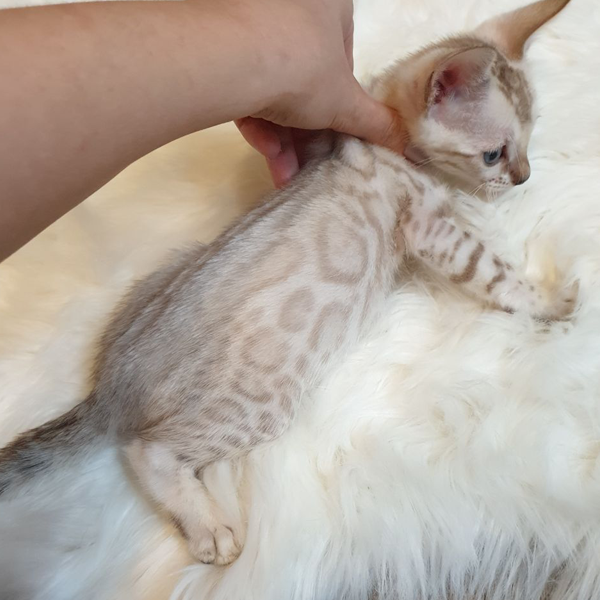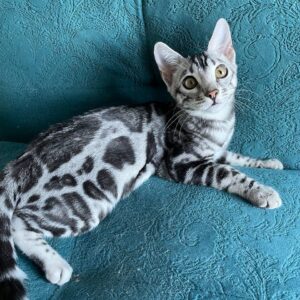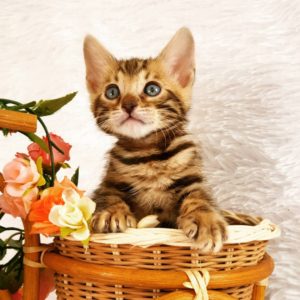Description
Snow Bengal kittens for sale was first bred in the United States and is a relative newcomer to the cat scene. They were created by crossing between the Asian Leopard Cat with domestic breeds and they are known to have outgoing personalities which when paired to their wild.
Good looks has seen the Bengal become a popular choice both as a companion and family pet.
The Snow Bengal Cat
Exquisite And Elegant; Reminiscent Of A Snow Leopard!
Selecting a snow Bengal kitten can be perplexing for pet buyers. A snow is not simply “a snow”. All snows have an ivory background with a contrasting pattern but there are many variations in this color class. In simple terms, a snow lynx point Bengal is the result of crossing an Asian Leopard cat with a Siamese cat. This produces a snow Bengal with a creamy white background, blue eyes, and contrasting markings. Most often, the snow lynx’s pattern is pale or not visible at birth, and darkens as it grows.
The snow sepia is the result of crossing an Asian Leopard cat with a Burmese cat. This produces the darkest of the snow Bengal. Since the Burmese gene is recessive to the Siamese gene, sepias are the rarest of the snows. Typically, they have a very light tan background with contrasting markings, and can have green, copper, or gold colored eyes.
A snow mink, then, is a combination of the lynx and sepia. These kittens are darker than the lynx but lighter than the sepia. Most often, the eye color is aqua. At birth, these kittens have a pattern that is distinguishable.
These lynx, mink, and sepia variations can be seen mixed into the silver, chocolate, blue, charcoal, and melanistic colors as well; creating a variety of shades and color combination possibilities for each of these colors.
SNOW BENGAL CAT FOR SALE
A snow Bengal cat is the most beautiful imitation of the snow leopard. The responsible genes for this beautiful Bengal cat color come from the Siamese cat (lynx gene). And the Burmese cat (Sepia gene) that were used to create the Bengal breed in the very beginning.
Snow Bengal Coats
There are many shades and patterns that snow Bengals can display. All Bengals are classified as either spotted or rosetted, but within the snow distinction, there are a number of beautiful shades that range between wintry white and soft amber.
- Snow seal lynx Bengals have the lightest coat of all snow Bengals, which presents as a pale cream color that contrasts beautifully with their blue eyes. A new owner who wants to make sure their new family member has blue eyes can count on a seal lynx kitten to deliver – they get this trait from their Siamese ancestors. Their base coats as kittens are typically pure white and will develop color with age.
- Snow seal mink Bengals have a slightly darker pattern than seal lynx that is best described as a creamy tan or ivory color. Seal mink Bengals will typically have bluish-green or aquamarine eyes, making these some of the most unusual of all Bengal eyes. Their base coats are a pale cream, which is a result of breeding a snow seal lynx Bengal with a snow seal sepia Bengal. Snow seal mink Bengals can be difficult to find for this reason.
- Snow seal sepia Bengals are sometimes referred to as “brown snow Bengals,” because they present the greatest contrast in their coats, which are a deeper, warm cream color that can range from pale to dark. Think of a sepia effect on a photograph: these Bengals look as if they have a light filter on their coats. Their eyes will reliably be green or gold, unlike other variations of snow Bengals. If a supposed snow seal sepia has blue eyes, it is actually either a snow seal lynx or a snow seal mink Bengal.
Snow Bengal Markings
Snow Bengals have paler markings than other Bengals, giving them less contrast against their base coats. Their markings present in the same shapes and patterns as other Bengals, however. These include rosetted (or spotted) and marbled markings, depending on their breeding.
Rosettes
Rosettes are exclusive to Bengals among domestic cats, which is part of the appeal of these gorgeous creatures. Rosettes can present in many different shapes and patterns, including paw-print, arrowhead, donut, clouded, and cluster. Breeders tend to focus on making the appearance of these rosettes more distinctive as generations pass, hence the wide range of possibilities.
Snow Bengals, especially seal lynx Bengals, are sometimes born with no rosettes at all. As they age, snow Bengals start to show their pale, creamy rosettes, which remain light throughout their adult lives.
Marbling
Marbled Bengals are a striking variety of these gorgeous cats, characterized by symmetrical swirls on their back and sides. Marbling is rarer than spotting in Bengals, due mostly to breeders’ preference for leopard-like spots. Either coat presentation on a snow Bengal is lovely – choosing between marbled versus rosetted is a matter of personal taste.
Other markings
All Bengals tend to have similar markings overall, even if they have different coat patterns. Universal among Bengals is a striped tail with a darker tip, tummy spots, and striped legs. Their faces have darker markings as well; some snow Bengals even have markings that appear to create “goggles” on their face. As regal as Bengals are, these markings scream “cute”!
What Is It Like Owning a Snow Bengal?
Bengals are an active breed that require considerable care and attention. They are very athletic and love to run around and play, sometimes even in the middle of the night. New and old cat owners alike might be in for a surprise when they adopt a Bengal for the first time, since they are unlike any other breed. Knowing what it is like to own a Bengal can help a new owner prepare to add one of these lovable creatures to the family.
They Are Very Athletic – and They Won’t Let You Forget It
Any Bengal owner can attest to the fact that these cats love to run around, climb up anything they see, and jump at prey. Bengals require plenty of space to play, or else they won’t burn off their huge amounts of energy. If I make the mistake of not tiring out my two Bengals before bed, they make sure to remind me that they still want to play, even while I’m sleeping!
Bengal owners should make sure to have tons of interactive toys and places to play. Without a healthy amount of stimulation, Bengals can become anxious and destructive. Giving your cat a Bengal-friendly environment can help them adjust well and thrive.
They Are Excellent Climbers
Due in part to their wild ancestry, Bengals simply adore climbing on any and all things. Investing in a tall cat tree is crucial to keeping your cat happy, or she will find other things to climb – even bookshelves aren’t safe! Keep this in mind when Bengal-proofing your house.
Bengals Are Talkative
Most cat owners have heard their furry friends meow now and again, but Bengals like to make their voices heard. This breed is known for its various noises, including meows, chirps, trills, and yowls. For the most part, these are happy noises – your Bengal just wants to be a part of the conversation! Sometimes, however, she is trying to tell you something. She could be hungry, bored, or in need of some belly rubs.
Bengals LOVE Water
Cats typically shy away from pools, baths, sinks, hoses, you name it! but Bengals play in the water as if they were born to do it. Some Bengals enjoy having a running tap to drink from and play with, though to save on your water bill, it is wise to invest in a running water fountain for her instead.
You Can Take Your Bengal for a Walk
This might be one of the most interesting quirks that Bengals are known for. Bengals enjoy taking walks outdoors on a leash, exactly like any dog would. Leash training from an early age is helpful in accomplishing this. Soon enough, your Bengal will want to take daily walks around the block!
They Are Great With Dogs
Unlike most cats, Bengals get along extremely well with their canine counterparts. If a Bengal is properly introduced to a dog, they will most likely become fast friends. Bengals and dogs are both very active and have a ton of fun playing together. Bengals are able to hold their own with dogs, being as athletic as they are.
Fact or Fiction: Bengals Aren’t Lap Cats
Many Bengal owners claim that while their furry friend is a lovable and friendly creature, they are notoriously opposed to snuggling on a human’s lap. In some cases, this is true, as Bengals prefer to run around and play – but it depends entirely upon the individual cat. My Bengals love to cuddle on my lap (Winston is here as I write this), and they sleep in my bed every night. It seems it is the luck of the draw!
Bengals Can Be Trained
Another unique characteristic of Bengals is their ability to be trained, much like a typical dog. They are very intelligent cats, and understand what their human wants, given the right incentive (treats, toys, you name it)! However, they are still cats, and might occasionally turn their nose up at a treat – this personality is why we love them.
Bengals Are Loyal
Many people adopt dogs in search of a loving, loyal pet. Bengals are the perfect alternative for pet owners who might not be able to house a dog – they are very loving and protective of their human parents. Some Bengals will follow their owner around the house all day, simply to be near them.
Bengals Can’t Help but Be Curious
The famous saying goes, “curiosity killed the cat” – this couldn’t be further from the truth with Bengals, who simply can’t help but poke around. They are incredibly inquisitive and love to explore any new places they encounter. It is important to keep an eye on your beloved Bengal, as they are very smart animals and will inevitably find their way into trouble!
Basics of owning a snow Bengal
Bengals, like any other cat, need a caring and attentive owner to ensure their health and safety. Bengals have many of the same needs as regular housecats, but because of their unique lineage, there are some important extras to be aware of.
Nutrition Is Important
Like all cats, Bengals are obligate carnivores, meaning that they MUST eat meat. If a new owner is strictly vegan and wants their pets to be the same, buying a Bengal is the wrong choice. Bengals require a high protein diet of both wet and dry food that has a minimal amount of filler carbohydrates.
Some Bengal owners choose to feed their cats a raw food diet, which can be a great option for these cats. The price can be somewhat prohibitive, however, and Bengals can get along just fine on a diet of regular, high-quality cat food. Bengals do love cooked chicken as a treat every once in a while!
When first bringing a Bengal home, it is important to keep her on the food she ate at her home cattery, and gradually transition her to a new type of food over a period of time. If her food is changed too abruptly, she will experience stomach problems.
Always Have Fresh Water
Bengals can be very picky about their water intake and prefer a flowing water fountain over a stagnant bowl of water. Having a constant supply of fresh water will encourage your Bengal to stay hydrated. She might even want to play with her water fountain!
Schedule Regular Vet Visits
Like any cat, Bengals need regular veterinary care to check for health problems, receive vaccines, get neutered/spayed, and all other things that accompany a visit to the vet. If an owner likes to take their Bengal on outdoor walks, it is crucial that the cat receive regular vaccines to prevent various diseases. Veterinarians will also provide owners with flea, tick, and heartworm medication, which are very important to a cat’s wellbeing.
Unless an owner plans to breed their Bengal, the cat should be spayed or neutered before it reaches sexual maturity. If the cat is allowed to mature in such a way, behavioral problems can develop, such as spraying, yowling, and other destructive actions.
Keep Your Bengal Busy
If a Bengal gets bored, she will probably start to play with things she isn’t supposed to, like power cords and window blinds. Without proper stimulation, a Bengal will grow anxious and display irregular behavior, like scratching furniture and random urination outside of the litter box. One solution to this is giving them plenty of toys and play time, while another is not as simple: get another cat.
While it may seem overkill to adopt two cats when you only wanted one, cats benefit greatly from having a companion to play with. In fact, some shelters will not allow an owner to adopt a solitary kitten – they must be adopted in pairs. If possible, adopting littermates is the best option. Originally, I only planned to adopt my Bengal Charlie, but after further investigation I realized he needed his brother Winston, too. Best (and easiest) choice I’ve ever made!
Show Them Plenty of Affection
Some Bengals act as if they are cold and aloof, but the truth is, every cat needs love and attention, and will suffer without it. Figuring out what your Bengal responds to is helpful in this regard; maybe she likes to play with a teaser toy, maybe she needs tummy scratches. No matter what, make sure she knows she is safe and loved. It can take some time to earn a Bengal’s trust, but once you have it, you have an unfailingly loyal friend.
3 Little-Known Facts About Snow Bengal Cats
1.Snow Bengals come in three colors
Bengal cats can have two main coat patterns: spotted or marbled.
A Snow Lynx Bengal cat will have a white or pale cream-colored coat with seal markings varying from dark to light in shade. They will have a dark brown tail tip and blue eyes.
A Snow Mink Bengal cat will have a cream, ivory, or light tan-colored coat, with dark seal mink to seal mink-colored markings. Their tail tip will be dark seal brown. They can have aqua or blue-green eyes.
A Snow Sepia Bengal cat will have an ivory, light tan, or cream coat overlaid with seal sepia to dark seal sepia markings. They will have a dark seal brown tail tip and green or gold eyes.
2.Snow Bengals love water
We all know that most cats aren’t exactly fond of water, but Snow Bengals will actively seek it out. These playful cats will jump at any opportunity to get their paws wet. They may try to jump in your bath, take a shower, or stick their paw under a running tap.
3.Bengal cats were originally a hybrid
The Bengal cat breed was created in the 1960s by crossing a wild Asian Leopard cat with domestic cats. They were recognized by the International Cat Association as an experimental breed in 1983 and fully recognized in 1991.
For a Snow Bengal to be accepted by breed registries as a Bengal cat, they must be F4. This means their parents (F3), grandparents (F2), and great grandparents (F1) must all be domestic Bengals. It will be their great, great grandparent that is an African Leopard cat.
Conclusion – Is a Snow Bengal Right for Me?
Knowing the facts about snow Bengals and their behavior is critical before deciding to adopt a new furry friend. Some first time cat owners struggle with owning Bengals, but if they are given the right amount of time and care, your cat will develop quite well. Charlie and Winston are my very first cats, and they are thriving! The key to raising a happy Bengal is having a happy owner who will give the cat everything she needs.





